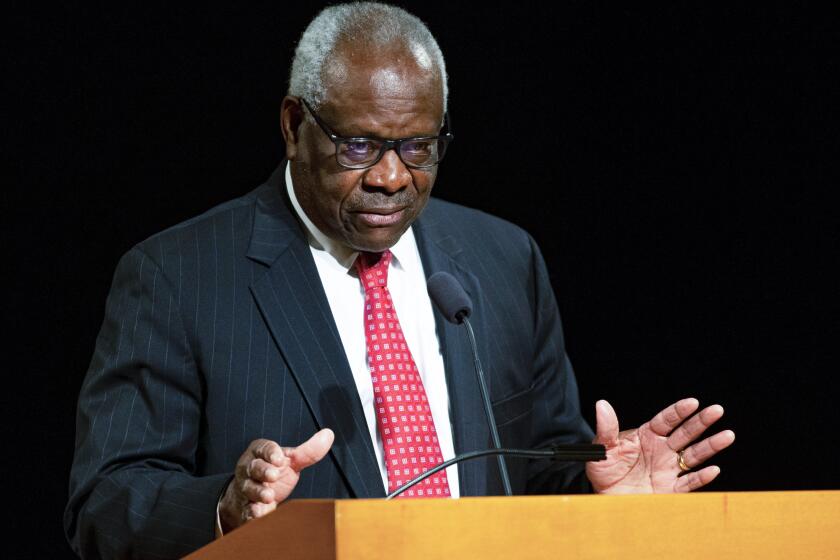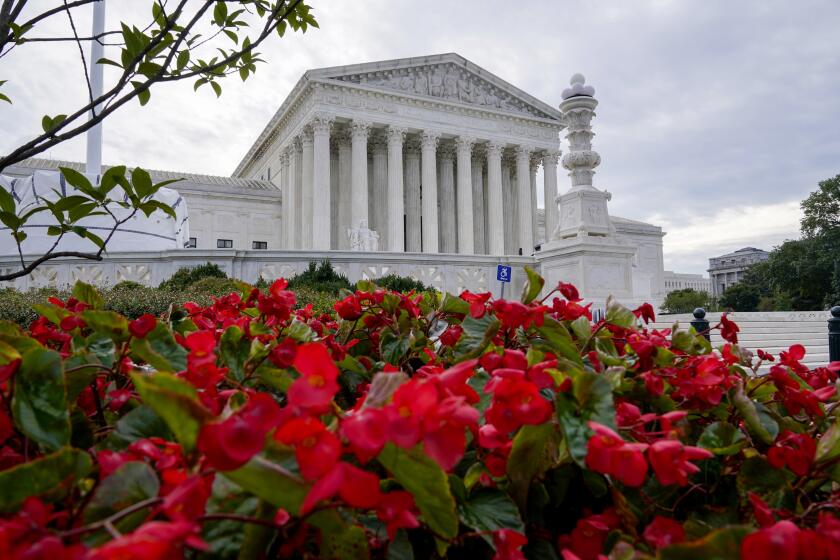- Share via
WASHINGTON — The crucial battles these days within the Supreme Court are among its six conservatives, not between them and the three liberals.
And the outcome in close cases now turns most often on one justice: Brett M. Kavanaugh.
Five years after he survived a bruising Senate confirmation, Kavanaugh has left little doubt about his conservative credentials, joining the 6-3 majority to roll back abortion rights and affirmative action. He voted to expand gun rights, block climate change policies and halt student loan forgiveness.
But Kavanaugh has shown he is not always a predictable vote, especially for the most conservative positions. He often joins Chief Justice John G. Roberts Jr. to hold the middle, and sometimes joins liberals to form a surprising 5-4 majority.
As the Supreme Court opens a new term Monday, where the conservative majority goes next depends in no small part on whether Kavanaugh aligns with Roberts, a conservative who prefers narrow rulings and gradual steps, or with Justices Clarence Thomas and Samuel A. Alito Jr., who have long sought to push the law further right.
At stake this term will be whether 2nd Amendment gun rights are expanded to include those accused of domestic violence, the legal status of abortion pills and how far conservative states can go in regulating social-media companies.
If the last year’s term was any indication, staunch conservatives may have reason to worry about Kavanaugh. He voted most often with Roberts. And he voted more often with the court’s three liberals than with Thomas, the most conservative justice.
Does the 2nd Amendment give gun rights to ex-felons and dangerous defendants? U.S. Supreme Court justices are about to decide.
In June, with the fate of the Voting Rights Act in doubt, Kavanaugh cast a fifth vote to join Roberts and rule that Alabama’s Republicans must draw a new congressional district that might elect a Black Democrat. They reaffirmed that position last month.
The four other conservatives joined a dissent by Thomas that would have barred considering the racial divide among the state’s voters when deciding whether a redistricting plan is fair.
Kavanaugh also joined the chief justice in June to reject a broad claim from North Carolina Republican leaders who said state legislators alone, not judges, had an independent power over federal elections. This theory arose when allies of then-President Trump claimed that GOP state legislators could appoint their own slate of electors, even if President-elect Biden had won more votes.
A year earlier, Kavanaugh cast a deciding fifth vote to uphold the Biden administration’s plan to require a COVID-19 vaccine for millions of workers at hospitals and nursing homes that receive Medicare and Medicaid funds.
As Kavanaugh noted, hospitals did not object to the requirement. Rather, the rules were challenged by 16 Republican state attorneys general.
Four other conservatives — including Trump-appointed Justices Neil M. Gorsuch and Amy Coney Barrett — dissented, contending hospital workers should not be required to undergo what Alito called “an irreversible medical treatment.”
Kavanaugh also split from the conservatives when a federal judge in Texas ruled that Navy SEALs had a religious right to refuse the military’s requirement of a COVID-19 vaccine, even when they were deployed on special missions.
Twice Kavanaugh played a key role in upholding Biden’s immigration policies against lawsuits brought by Texas Republicans.
He did so citing his experience working in the White House under President George W. Bush. He did not contend the Republican policies on immigration were right, but instead that a Democrat in the White House deserved the same authority to set new policies as a Republican.
The immigration law “affords substantial discretion to the executive,” he wrote in a 5-4 ruling in Biden vs. Texas, and “different presidents may exercise it differently.”
Kavanaugh’s emergence as the sometimes unpredictable middle vote did not surprise Washington attorney Lisa Blatt.
Blatt, who has argued more cases before the court than any other woman, drew sharp criticism for endorsing Kavanaugh’s confirmation in 2018.
She said then she was a “liberal feminist” who had clerked for Justice Ruth Bader Ginsburg and wished Ginsburg had “all nine votes.” But with Republicans in control of the White House and the Senate, she said Kavanaugh was “the best choice ... in these circumstances.”
Kavanaugh’s “first five years are exactly what I thought they would be,” she says now. Although disappointed that Kavanaugh and the court overturned the right to an abortion in the Dobbs case, she said his overall record “shows he’s a mainstream conservative who is acutely aware of the practical consequences of the court’s decisions. I think this is Justice Kavanaugh’s court, meaning his vote will continue to have a decisive effect in the court’s most important cases.”
Kavanaugh has forged a style and philosophy distinct from his fellow conservatives.
He and Gorsuch have been friends since high school, but they take a different approach to judging and often disagree.
Gorsuch focuses intently on his sometimes distinct view of the legal issue in the case, not on the practical impact of a decision. At oral arguments, Kavanaugh often asks lawyers on both sides about the consequences of a decision for one side or other.
Roberts and Kavanaugh came up as mainstream conservatives in the Reagan-Bush era. They now confront a legal agenda driven by far more conservative Trump-appointed judges in states like Texas and Louisiana.
Kavanaugh has been generally more conservative than Roberts, including on abortion, but not always.
In the last term’s most important environmental case, Kavanaugh disagreed with the five conservatives who ended federal protection for wetlands that are not part of a continuously flowing body of water.
In Sackett vs. EPA, Kavanaugh said that since 1977, Congress and eight presidential administrations had agreed that wetlands that were “adjacent” to rivers, lakes or bays were protected under federal authority. Justices Elena Kagan, Sonia Sotomayor and Ketanji Brown Jackson agreed.
David Cole, the American Civil Liberties Union’s legal director, said Kavanaugh has “shown himself to be an institutionalist. He plainly has conservative commitments, but like Chief Justice Roberts and, increasingly, Justice Barrett, he seems sensitive to the need to respect precedent and to seek results that are not divided along partisan lines.”
He noted Kavanaugh, like retired Justice Anthony M. Kennedy, sometimes writes “plain-spoken concurrences aimed at the general public and attempting to speak to both sides. And the very effort to speak to both sides may in turn encourage a kind of moderation.”
Kavanaugh says he aspires to be a careful judge who decides cases based on the law, not politics.
But liberal critics scoff at the notion he is holding the middle and point out that he has not yet written significant majority opinions for the court.
“This is an incredibly conservative court, and he’s a predictable conservative vote,” said Carolyn Shapiro, a professor at the Chicago-Kent College of Law. “He’s not a moderate or a moderate conservative. He will vote with the conservatives and then try to narrow the holding.”
“I think it is important to not overstate the differences between Kavanaugh and the other conservatives,” said UC Berkeley law dean Erwin Chemerinsky. On the major cases, he has voted with the conservative majority, he said. “My sense overall is that he has had an undistinguished first few years on the court,” he added.
California voters overwhelmingly disapprove of the current U.S. Supreme Court, with many describing it as too political and conservative.
In stark contrast to his combative confirmation hearing, Kavanaugh displays a cheerful, upbeat manner and, like now-retired liberal Justice Stephen G. Breyer, he often talks about how well his colleagues work with each other despite their disagreements on the law.
“There are great relations among the nine justices, both personally and professionally,” Kavanaugh told students recently at the Notre Dame Law School. The justices eat lunch together after oral arguments, and their rule is that they don’t talk about cases.
“That is a lot of lunches. So you talk about things that you do with other people in your life. We talk about our kids, movies, books, war stories ... again and again,” Kavanaugh said. “You become friends.”
He also speaks proudly of making new friends, including those across the ideological aisle. Judge Michelle Childs is a Biden appointee who replaced Jackson on the D.C. Court of Appeals, and is also a basketball fan. When Kavanaugh learned that, he invited her and Kagan to go to a basketball game last winter.
For most, his public image is of a scowling nominee angrily denying the allegation that he and a drunken friend had assaulted Christine Blasey Ford when they were teenagers. He won Senate confirmation on a mostly party-line vote of 50-48.
Many years ago, Thomas and Alito endured sharp criticism from Democrats at their confirmation hearings, including from then-Sen. Joe Biden, and both have carried a grudge and an air of grievance ever since.
Kavanaugh, by contrast, appears to have put the experience behind him. He often speaks of living on the “sunny side of the mountain,” looking forward to a new day and not back.
“If I had to predict the next five years for him,” Blatt said, “I think he will be the conservative version of Justice Breyer, if he is not already. Very well-liked by all his colleagues and trying to find middle ground.”
More to Read
Sign up for This Evening's Big Stories
Catch up on the day with the 7 biggest L.A. Times stories in your inbox every weekday evening.
You may occasionally receive promotional content from the Los Angeles Times.













